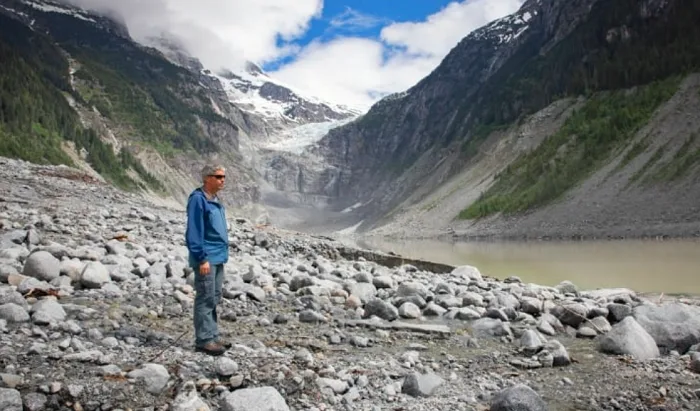
B.C. landslide triggered 100-metre tall lake tsunami, study shows
A massive landslide on B.C.'s remote central coast in 2020 triggered a lake tsunami over 100 metres tall, according to a new paper published by researchers from the University of Northern British Columbia.
Described as a rare "hazard cascade," the tsunami then sent a vast torrent of water or "outburst flood" into Elliot Creek, uprooting trees, soil and rock as it surged down the valley. The slurry was in turn propelled in the Southgate River and then Bute Inlet, leaving a devastated landscape in its wake.
"Imagine a landslide with a mass equal to all of the automobiles in Canada, travelling with a velocity of about 140 kilometres an hour when it runs into a large lake," said lead author Marten Geertsema, adjunct professor of ecosystem science at UNBC.

Brian Menounos, a professor of geography at the University of Northern British Columbia, surveys a debris field caused by a landslide and outburst flood off the coast of B.C. (Briar Stewart/CBC News)
"The landslide displaced enough water to cause a tsunami with a wave height that exceeded 100 metres. This drained most of the lake water which then travelled down a 10-kilometre-long channel causing widespread channel erosion and loss of salmon habitat."
According to the study, the torrent destroyed 8.5 kilometres of salmon spawning ground and sent a plume of sediment and organic matter 60 kilometres into Bute Inlet.

A massive landslide on B.C.'s remote central coast triggered a lake tsunami over 100 metres tall, sending an 'outburst flood' into Elliot Creek — uprooting trees, soil and rock — which then propelled in the Southgate River and then Bute Inlet. (CBC)
Rapid thinning and retreat of the glacier at the slide site set the stage for the hazard cascade, according to the study co-author.
"Once you lose the supporting structure of the ice that is backstopping and protecting these steep slopes, they are much more susceptible to failure," said UNBC geography professor Brian Menounos.
The slide registered the equivalent of a 5.0-magnitude earthquake and was first detected by someone at Columbia University in the U.S. who was monitoring seismic signals.
Although scientists knew the general area where it had occurred, it wasn't until a Vancouver Island helicopter pilot started posting about debris in Bute Inlet and devastation to Southgate River and Elliot Creek, that they were able to zero in on the precise site of the slide and a large scar on a mountain where it had all started.
With the climate continuing to warm and glacier melt accelerating, Menounos said the research will provide better understanding of the potential for similar events.
"If you look at other steep areas in British Columbia, we do know that the glaciers will continue to retreat, exposing these steep slopes," he said. "If you had this sort of situation happen in a more densely populated corridor, the Squamish Valley, for example, and the Sea-to-Sky, then you actually start to have these consequences that are going to directly affect people."

The landslide scoured the Elliot Creek bed, creating this canyon, after an initial outflow into a glacial lake triggered an outburst flood. (Bastian Fleury/49 North Helicopters)
The slide, tsunami and flood all happened in Homalco First Nation territory. No one is known to have been injured or killed.
Menounos said participation of the Homalco First Nation members was crucial to the research.
"It's a really proud moment," said Menounous. "It's incredibly important to co-create knowledge going forward. It's their land and we feel most proud to work with them directly."
This article was written for the CBC.